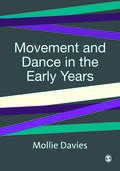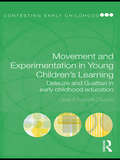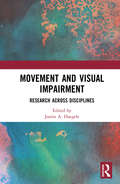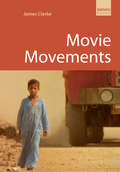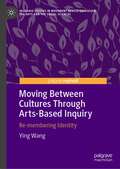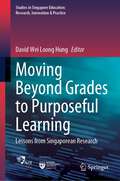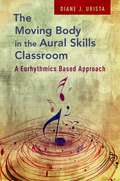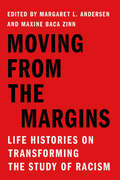- Table View
- List View
Movement and Dance in Early Childhood
by Dr Mollie Davies`This original and fascinating approach to children's movement development is highly recommended reading for tutors, practitioner and students alike' - Under Five `Movement and Dance in Early Childhood offers a clear and accessible entry into the world of movement and dance and the possibilities that exist for children, their families and the wider educational community' - Every Child `Eminently readable and accessible. Whether the reader is versed in movement understanding or a beginner, by the end of the book they should be a much better movement observer, teacher and handler' - Marion North, Principal and Chief Executive, Laban Centre for Movement and Dance In this unique and innovative book on movement and dance development from birth to eight years, the author draws on her depth of knowledge and practical experience in helping children to become skilled, creative and imaginative in a wide range of movement-oriented activities. The book seeks to help early childhood educators and parents in very practical ways and provides guidance based on a sound theoretical understanding. Originally published as Helping Children Learn Through a Movement Perspective, this book has been updated in the light of recent research. The author extends her investigation of how young children learn in and through movement. There is an expanded chapter on dance, which suggests strategies for working with young children and examines ways in which young children take on the roles of dance-makers, performers and appreciators. An additional chapter shows ways in which the expressive and artistic aspects of children's movement can be appropriately located and includes exemplars for dance at Key Stage 1 and the early phases of Key Stage 2.
Movement and Dance in Early Childhood (PDF)
by Dr Mollie Davies`This original and fascinating approach to children's movement development is highly recommended reading for tutors, practitioner and students alike' - Under Five `Movement and Dance in Early Childhood offers a clear and accessible entry into the world of movement and dance and the possibilities that exist for children, their families and the wider educational community' - Every Child `Eminently readable and accessible. Whether the reader is versed in movement understanding or a beginner, by the end of the book they should be a much better movement observer, teacher and handler' - Marion North, Principal and Chief Executive, Laban Centre for Movement and Dance In this unique and innovative book on movement and dance development from birth to eight years, the author draws on her depth of knowledge and practical experience in helping children to become skilled, creative and imaginative in a wide range of movement-oriented activities. The book seeks to help early childhood educators and parents in very practical ways and provides guidance based on a sound theoretical understanding. Originally published as Helping Children Learn Through a Movement Perspective, this book has been updated in the light of recent research. The author extends her investigation of how young children learn in and through movement. There is an expanded chapter on dance, which suggests strategies for working with young children and examines ways in which young children take on the roles of dance-makers, performers and appreciators. An additional chapter shows ways in which the expressive and artistic aspects of children's movement can be appropriately located and includes exemplars for dance at Key Stage 1 and the early phases of Key Stage 2.
Movement And Experimentation In Young Children's Learning: Deleuze And Guattari In Early Childhood Education
by Liselotte Borgnon Liselott Mariett OlssonIn contemporary educational contexts young children and learning are tamed, predicted, supervised, controlled and evaluated according to predetermined standards. Contesting such intense governing of the learning child, this book argues that the challenge to practice and research is to find ways of regaining movement and experimentation in subjectivity and learning. Vivid examples from Swedish preschools – involving children, teachers, teacher students and educators and researchers - are woven together with the theories of French philosophers Gilles Deleuze and Félix Guattari, bringing important new concepts and practices to the early childhood field. This ground-breaking book investigates three key areas: the need to focus on ‘process’ rather than ‘position’, as positioning of any kind, such as learning goals or developmental stages, hampers movement. working with methods that recognise science’s inventiveness and productivity, demonstrating how the events in which children take part can remain open ended and in movement. Re-considering the dichotomy between the individual and society as a ‘cause and effect’ relationship, which immobilizes subjectivity and learning and hinders experimentation. Challenging dominant ways of thinking, Movement and Experimentation in Young Children's Learning offers new possibilities for change and provokes a re-evaluation of the educational system’s current emphasis on predetermined outcomes and fixed positions. This book provides researcher and students with a sound theoretical framework for re-conceptualising significant aspects of movement and experimentation in early childhood. Its many practical illustrations make this a compelling and provocative read for and student taking course in Early Childhood Studies.
Movement and Experimentation in Young Children's Learning: Deleuze and Guattari in Early Childhood Education (Contesting Early Childhood)
by Liselott Mariett OlssonIn contemporary educational contexts young children and learning are tamed, predicted, supervised, controlled and evaluated according to predetermined standards. Contesting such intense governing of the learning child, this book argues that the challenge to practice and research is to find ways of regaining movement and experimentation in subjectivity and learning. Vivid examples from Swedish preschools – involving children, teachers, teacher students and educators and researchers - are woven together with the theories of French philosophers Gilles Deleuze and Félix Guattari, bringing important new concepts and practices to the early childhood field. This ground-breaking book investigates three key areas: the need to focus on ‘process’ rather than ‘position’, as positioning of any kind, such as learning goals or developmental stages, hampers movement. working with methods that recognise science’s inventiveness and productivity, demonstrating how the events in which children take part can remain open ended and in movement. Re-considering the dichotomy between the individual and society as a ‘cause and effect’ relationship, which immobilizes subjectivity and learning and hinders experimentation. Challenging dominant ways of thinking, Movement and Experimentation in Young Children's Learning offers new possibilities for change and provokes a re-evaluation of the educational system’s current emphasis on predetermined outcomes and fixed positions. This book provides researcher and students with a sound theoretical framework for re-conceptualising significant aspects of movement and experimentation in early childhood. Its many practical illustrations make this a compelling and provocative read for and student taking course in Early Childhood Studies.
Movement and Experimentation in Young Children's Learning: Deleuze and Guattari in Early Childhood Education (Contesting Early Childhood)
by Liselott Mariett OlssonIn contemporary educational contexts young children and learning are tamed, predicted, supervised, controlled and evaluated according to predetermined standards. Contesting such intense governing of the learning child, this book argues that the challenge to practice and research is to find ways of regaining movement and experimentation in subjectivity and learning. Vivid examples from Swedish preschools – involving children, teachers, teacher students and educators and researchers - are woven together with the theories of French philosophers Gilles Deleuze and Félix Guattari, bringing important new concepts and practices to the early childhood field. This ground-breaking book investigates three key areas: the need to focus on ‘process’ rather than ‘position’, as positioning of any kind, such as learning goals or developmental stages, hampers movement. working with methods that recognise science’s inventiveness and productivity, demonstrating how the events in which children take part can remain open ended and in movement. Re-considering the dichotomy between the individual and society as a ‘cause and effect’ relationship, which immobilizes subjectivity and learning and hinders experimentation. Challenging dominant ways of thinking, Movement and Experimentation in Young Children's Learning offers new possibilities for change and provokes a re-evaluation of the educational system’s current emphasis on predetermined outcomes and fixed positions. This book provides researcher and students with a sound theoretical framework for re-conceptualising significant aspects of movement and experimentation in early childhood. Its many practical illustrations make this a compelling and provocative read for and student taking course in Early Childhood Studies.
Movement And Experimentation In Young Children's Learning (PDF): Deleuze And Guattari In Early Childhood Education
by Liselotte Borgnon Liselott Mariett OlssonIn contemporary educational contexts young children and learning are tamed, predicted, supervised, controlled and evaluated according to predetermined standards. Contesting such intense governing of the learning child, this book argues that the challenge to practice and research is to find ways of regaining movement and experimentation in subjectivity and learning. Vivid examples from Swedish preschools – involving children, teachers, teacher students and educators and researchers - are woven together with the theories of French philosophers Gilles Deleuze and Félix Guattari, bringing important new concepts and practices to the early childhood field. This ground-breaking book investigates three key areas: 1. The need to focus on ‘process’ rather than ‘position’, as positioning of any kind, such as learning goals or developmental stages, hampers movement. 2. Working with methods that recognise science’s inventiveness and productivity, demonstrating how the events in which children take part can remain open ended and in movement. 3. Re-considering the dichotomy between the individual and society as a ‘cause and effect’ relationship, which immobilizes subjectivity and learning and hinders experimentation. Challenging dominant ways of thinking, Movement and Experimentation in Young Children's Learning offers new possibilities for change and provokes a re-evaluation of the educational system’s current emphasis on predetermined outcomes and fixed positions. This book provides researcher and students with a sound theoretical framework for re-conceptualising significant aspects of movement and experimentation in early childhood. Its many practical illustrations make this a compelling and provocative read for and student taking course in Early Childhood Studies.
Movement and Learning in the Early Years: Supporting Dyspraxia (DCD) and Other Difficulties
by Dr Christine Macintyre Kim Mcvitty`This book achieves what it sets out to do - provide clear guidance to parents and professionals on key aspects of movement in the early years. The book however does more than that - it emphasises that movement in the early years is not the territory of experts, but through the use of this book, the assessment of movement development of activities and programmes are within the range of all - class teachers and parents. I strongly recommend that this book is available in every school' - Educational Review `This book provides a good overview of issues in movement and development and learning, and will stimulate the interested reader to explore this topic further' - Early Years `This book will be a useful addition to any primary staff room bookshelf. It is a practical book based on sound theory. It will provide ideas for the non-specialist teacher and for parents anxious to help. The suggestions will provide a good framework for the staged assessment and support for young children for whom there is a cause for concern' - Support for Learning `For anyone involved in the development of any young child, this should be essential reading. The book is very informative and readable by parents, teachers and students and is simply illustrated with case studies' - Dyslexia Contact `As a behaviour advisory teacher I will certainly be influenced by reading this, and I know our local occupational therapists would be overjoyed if she knew all teachers read books like this' - Special Children `It is always good to be able to welcome a book on such a key factor as movement in early childhood development, and this text has been written to support parents and practitioners who wish to understand how movement contributes to all aspects of learning -intellectual, social and emotional, as well as physical' - Marian Whitehead, Nursery World `This book is an excellent introduction for anybody trying to understand how movement affects child development. It clearly explains the importance movement has on how young children learn and feel. The information and insights in this book can be found elsewhere but I have yet to find such breadth and depth of information on supporting children with movement difficulties as clearly written and accessible as this book' - Spare-Chair `The book is very informative and readable by parents, teachers and students and amply illustrated with case studies' - Judith Stansfield, SEN ICT Consultant Movement is a key factor in young children's development and it can affect how they learn and how they feel. Do you work with young children who have difficulties in this area? This book shows you how to observe a child as they move to allow for early identification of any problem and then tells you how to help. Dyspraxia (DCD) is on the increase in young children and less confident and easy movement can play a part in other specific learning difficulties such as dyslexia, attention deficit disorder (ADD) and with hyperactivity (ADHD). Included is advice on: } observing, analyzing and assessing movement development } building confidence } helping with handwriting } supporting mathematical development Why not ask the child to pop bubble paper as one way of promoting finger awareness? Carefully taught activities can be easy to plan and fun to carry out and there are lots of suggested activities set out in the book. Early years practitioners in nurseries, schools, playgroups and EYDCPs will find this book clear and useful; it also offers advice to parents. Christine Macintyre was formerly Senior Lecturer at Edinburgh University and is now a freelance consultant. Kim McVitty is a nursery school teacher.
Movement and Learning in the Early Years: Supporting Dyspraxia (DCD) and Other Difficulties (PDF)
by Dr Christine Macintyre Kim Mcvitty`This book achieves what it sets out to do - provide clear guidance to parents and professionals on key aspects of movement in the early years. The book however does more than that - it emphasises that movement in the early years is not the territory of experts, but through the use of this book, the assessment of movement development of activities and programmes are within the range of all - class teachers and parents. I strongly recommend that this book is available in every school' - Educational Review `This book provides a good overview of issues in movement and development and learning, and will stimulate the interested reader to explore this topic further' - Early Years `This book will be a useful addition to any primary staff room bookshelf. It is a practical book based on sound theory. It will provide ideas for the non-specialist teacher and for parents anxious to help. The suggestions will provide a good framework for the staged assessment and support for young children for whom there is a cause for concern' - Support for Learning `For anyone involved in the development of any young child, this should be essential reading. The book is very informative and readable by parents, teachers and students and is simply illustrated with case studies' - Dyslexia Contact `As a behaviour advisory teacher I will certainly be influenced by reading this, and I know our local occupational therapists would be overjoyed if she knew all teachers read books like this' - Special Children `It is always good to be able to welcome a book on such a key factor as movement in early childhood development, and this text has been written to support parents and practitioners who wish to understand how movement contributes to all aspects of learning -intellectual, social and emotional, as well as physical' - Marian Whitehead, Nursery World `This book is an excellent introduction for anybody trying to understand how movement affects child development. It clearly explains the importance movement has on how young children learn and feel. The information and insights in this book can be found elsewhere but I have yet to find such breadth and depth of information on supporting children with movement difficulties as clearly written and accessible as this book' - Spare-Chair `The book is very informative and readable by parents, teachers and students and amply illustrated with case studies' - Judith Stansfield, SEN ICT Consultant Movement is a key factor in young children's development and it can affect how they learn and how they feel. Do you work with young children who have difficulties in this area? This book shows you how to observe a child as they move to allow for early identification of any problem and then tells you how to help. Dyspraxia (DCD) is on the increase in young children and less confident and easy movement can play a part in other specific learning difficulties such as dyslexia, attention deficit disorder (ADD) and with hyperactivity (ADHD). Included is advice on: } observing, analyzing and assessing movement development } building confidence } helping with handwriting } supporting mathematical development Why not ask the child to pop bubble paper as one way of promoting finger awareness? Carefully taught activities can be easy to plan and fun to carry out and there are lots of suggested activities set out in the book. Early years practitioners in nurseries, schools, playgroups and EYDCPs will find this book clear and useful; it also offers advice to parents. Christine Macintyre was formerly Senior Lecturer at Edinburgh University and is now a freelance consultant. Kim McVitty is a nursery school teacher.
Movement and Visual Impairment: Research across Disciplines
by Justin A. HaegeleThis is the first book to offer an in-depth review of research pertaining to individuals with visual impairments across the full span of movement-related disciplines, from biomechanics and motor learning to physical education and Paralympic sport. Each chapter highlights current research trends, future research directions, and practical implications in a key discipline or area of professional practice, drawing on empirical research evidence and opening up new avenues for cross-disciplinary working. Covering physical activity across the life course, from children and young people through to older adults, and addressing the important topic of deafblindness in some depth, the book goes further than any other book published to date on visual impairment and movement. This is essential reading for all advanced students and researchers working in sport, exercise and disability, and an invaluable reference for practitioners and service providers, from in-service teachers and camp directors to physical therapists and physical activity promotion specialists.
Movement and Visual Impairment: Research across Disciplines
by Justin A. HaegeleThis is the first book to offer an in-depth review of research pertaining to individuals with visual impairments across the full span of movement-related disciplines, from biomechanics and motor learning to physical education and Paralympic sport. Each chapter highlights current research trends, future research directions, and practical implications in a key discipline or area of professional practice, drawing on empirical research evidence and opening up new avenues for cross-disciplinary working. Covering physical activity across the life course, from children and young people through to older adults, and addressing the important topic of deafblindness in some depth, the book goes further than any other book published to date on visual impairment and movement. This is essential reading for all advanced students and researchers working in sport, exercise and disability, and an invaluable reference for practitioners and service providers, from in-service teachers and camp directors to physical therapists and physical activity promotion specialists.
The Movement Environment Rating Scale (MOVERS): Supporting Physical Development and Movement Play in Early Childhood
by Carol Archer Iram SirajThis revised new edition of The Movement Environment Rating Scale (MOVERS) offers a brand-new method of measuring the quality of environment and pedagogy in which young children are encouraged to move and be physically active.As physical development is a key component of an educational curriculum, MOVERS offers practitioners the opportunity to accurately assess the quality of a child’s physical experiences, and the environmental and pedagogical quality of these experiences. The MOVERS is placed firmly in the family of CLIQRS – Curriculum, Leadership and Interaction Quality Rating Scales, which includes the Early Childhood Quality Rating Scale – Emergent Curriculum (ECQRS-EC), the Sustained Shared Thinking and Emotional Well-being Scale (SSTEW) and the Pedagogical Leadership in the Early Years (PLEY) scale, all of which have a similar format to previously mentioned scales, making it easy for educators already familiar with these well-established scales to adopt them and adapt them to their own unique settings. MOVERS has four sub-scales:- curriculum, environment and resources for physical development- pedagogy for physical development- supporting physical activity and critical thinking- parents/carers and staff.This book will be an invaluable tool for research, self-evaluation and improvement, audit and regulation. With additional notes derived using the feedback from extensive use of this resource by practitioners in hundreds of settings and early years specialists around the world, it has also been rigorously updated according to latest research, practice and policy.
The Movement Environment Rating Scale (MOVERS): Supporting Physical Development and Movement Play in Early Childhood
by Carol Archer Iram SirajThis revised new edition of The Movement Environment Rating Scale (MOVERS) offers a brand-new method of measuring the quality of environment and pedagogy in which young children are encouraged to move and be physically active.As physical development is a key component of an educational curriculum, MOVERS offers practitioners the opportunity to accurately assess the quality of a child’s physical experiences, and the environmental and pedagogical quality of these experiences. The MOVERS is placed firmly in the family of CLIQRS – Curriculum, Leadership and Interaction Quality Rating Scales, which includes the Early Childhood Quality Rating Scale – Emergent Curriculum (ECQRS-EC), the Sustained Shared Thinking and Emotional Well-being Scale (SSTEW) and the Pedagogical Leadership in the Early Years (PLEY) scale, all of which have a similar format to previously mentioned scales, making it easy for educators already familiar with these well-established scales to adopt them and adapt them to their own unique settings. MOVERS has four sub-scales:- curriculum, environment and resources for physical development- pedagogy for physical development- supporting physical activity and critical thinking- parents/carers and staff.This book will be an invaluable tool for research, self-evaluation and improvement, audit and regulation. With additional notes derived using the feedback from extensive use of this resource by practitioners in hundreds of settings and early years specialists around the world, it has also been rigorously updated according to latest research, practice and policy.
Movie Magic in the Classroom: Ready-to-Use Guide for Teaching SEL
by Amber ChandlerMovies belong in the curriculum—and not just the day before a holiday. This book by award-winning educator Amber Chandler shows why films are so important for teaching social emotional learning and critical thinking. She provides complete guides to ten current, age-appropriate movies; each guide features a pre-viewing activity, a stop-and-chat guide for you so you know when to pause for discussion, a student notes sheet, and discussion questions with varying formats. The book also offers handy tools such as blank templates and permissions forms for communication with parents.Every movie addresses some aspects of CASEL’s SEL Competencies: Self-Awareness, Self-Management, Responsible Decision-Making, Relationship Skills, and Social Awareness. Amber Chandler does all the prep work for you, so you can lean into the movie experience and share this opportunity with your students, putting movie magic to work!
Movie Magic in the Classroom: Ready-to-Use Guide for Teaching SEL
by Amber ChandlerMovies belong in the curriculum—and not just the day before a holiday. This book by award-winning educator Amber Chandler shows why films are so important for teaching social emotional learning and critical thinking. She provides complete guides to ten current, age-appropriate movies; each guide features a pre-viewing activity, a stop-and-chat guide for you so you know when to pause for discussion, a student notes sheet, and discussion questions with varying formats. The book also offers handy tools such as blank templates and permissions forms for communication with parents.Every movie addresses some aspects of CASEL’s SEL Competencies: Self-Awareness, Self-Management, Responsible Decision-Making, Relationship Skills, and Social Awareness. Amber Chandler does all the prep work for you, so you can lean into the movie experience and share this opportunity with your students, putting movie magic to work!
Movie Movements: Films That Changed the World of Cinema
by James ClarkeMovie Movements: Films That Changed the World of Cinema is a one-stop guide to the major movements that have shaped our sense of what cinema is and can be. It introduces the reader to definitions of the founding concepts in Film Studies such as authorship and genre, technological impacts and the rise of digital cinema, social influences and notions of the avant-garde, and cinema's emergence as a major art form that reflects and shapes the world.It explores, in concise and clear sections, how major works from the classic French realist La Regle de Jeu to the dazzling animation of Norman McLaren and the memorial documentary of Shoah, were conceived, developed and produced, and eventually received by the public, critics and film history.Offering a concise overview of a vast and compelling subject, it's a book for both the film enthusiast and the Film Studies student.Films discussed by James Clarke include:KesRome, Open CityMetropolisThe Passion of Joan of ArcThe Tales of HoffmannThe Seventh SealThe Seventh SealLa Belle et la BêteUn Chien AndalouKoyaanisqatsiNight MailRome, Open CityThe Passion of Joan of ArcThe Tales of HoffmannThe Seventh SealUn Chien AndalouKoyaanisqatsiNight MailNanook of the NorthInto Great SilenceWe Are the Lambeth BoysBattleship PotemkinJules et JimPicnic at Hanging RockWings of DesireThe Hired HandSeven SamuraiPan's Labyrintk'Movie Movements is part of the Kamera book series, which are helpful guides to random cinema-related phenomena' - Film Ireland
The Moviemaking with Your Camera Field Guide: The Essential Guide to Shooting Video with HDSLRs and Digital Cameras (Field Guide)
by Olivia SperanzaAny photographer with a modern digital camera can be a moviemaker, and this book shows you all the skills you'll need to shoot everything, from a video-blog to a feature film. Build on your photographic skills - this knowledge predisposes you to create great cinematography - and understand the technical and practical necessities of high-definition video.The Moviemaking With Your Camera Field Guide shows you how you can build on what you already know to create truly spectacular movies with your DSLR in whatever genre you choose. It introduces everything from the language of film and basic equipment you will need, to the art of post-production and publishing your new work.Exclusive video content to accompany this book is available online.
Moving Between Cultures Through Arts-Based Inquiry: Re-membering Identity (Palgrave Studies in Movement across Education, the Arts and the Social Sciences)
by Ying WangThis book is an exploration of the concept of in-betweenness, as it occurs within the process of moving between the author’s root culture and adopted culture, from her perspective as an immigrant creative arts therapist. Through the critical autoethnographic voice and a/r/tographic inquiry, she introduces a unique exploration site within the process of Guqin-making, an ancient Chinese art form. Through the creation of images and poetry, and through Guqin-making and music-making/playing, the book expands the discussion of in-betweenness by re-theorising ancient Chinese philosophical perspectives on harmonic space. This contribution to arts-based research provides a unique standpoint to explore research methods of moving, walking, making, resting and awakening. It showcases how other researchers can transfer the invisible and intangible embodied feelings, memories and emotions arising from moving between two or more cultures into visible and tangible images, narrative, poetry, craft and music-playing to conduct powerful, interdisciplinary arts-based research.
Moving Beyond Grades to Purposeful Learning: Lessons from Singaporean Research (Studies in Singapore Education: Research, Innovation & Practice #5)
by David Wei Loong HungThis book explores future directions in Singaporean education as it moves beyond its historically formative goals of survival, efficiency and performance, and its emphasis on grades and formal credentialing. It examines the future of education via the 4Life framework, a four-form model for purposeful learning centered around social-emotional regulation and the well-being of the individual learner: Life-long learning, the learning that occurs over a learner's lifespan; Life-deep learning, a deep understanding of learned content and adaptive expertise; Life-wide learning, learning in multiple contexts besides the school environment; and Life-wise learning, learning which focuses on the learner's values, morals, character and historical empathy. This book also illustrates how purposeful learning serves to equip learners with the knowledge, skills, dispositions and competencies they need to thrive as adaptive workers in the economy of the future.
The Moving Body in the Aural Skills Classroom: A Eurythmics Based Approach
by Diane J. UristaInspired by Dalcroze-eurhythmics, this book is a practical guide for teachers and students interested in integrating the moving body into the aural skills classroom. Author Diane J. Urista focuses on movement-to-music as a tool for developing musical perception and the kinesthetic aspects of performance. As this book demonstrates, moving to music and watching others move cultivates an active, multi-sensory learning experience in which students learn by discovery and from each other. The book features a wealth of exercises that teach rhythmic, melodic, harmonic and formal concepts, including improvisation and expressive exercises. These exercises not only develop the ear, but also awaken the muscular and nervous system, foster mind-body connections, strengthen the powers of concentration, develop inner-hearing, short- and long-term memory, multi-tasking skills, limb autonomy, and expressive freedom. Exercises are presented in a graded but flexible order allowing readers to select individual exercises in any sequence. Activities involve movement through space as well as movement in place for those teaching in small classrooms. The book can be used as a teacher's manual, a supplementary aural-skills textbook, or as a stand-alone reference in a course dedicated to eurhythmics. Many exercises also provide an effective aural/sensory tool in the music theory classroom to complement verbal explanations. The approach integrates easily into any traditional college or conservatory classroom and is compatible with fixed do, moveable do, and scale degrees. A companion website features undergraduate students performing select exercises. Visit the companion website at www.oup.com/us/movingbodyauralskillsclassroom
Moving Critical Literacies Forward: A New Look at Praxis Across Contexts
by Jessica Pandya JuliAnna ÁvilaTaking the pulse of current efforts to do—and, in some cases, undo—critical literacy, this volume explores and critiques its implementation in learning contexts around the globe. An impressive set of international authors offer examples of productive critical literacy practices in and out of schools, address the tensions and gaps between these practices and educational policies, and attempt to forecast the future for critical literacy as a movement in the changing global educational policy landscape. This collection is unique in presenting the recent work of luminaries such as Allan Luke and Hilary Janks alongside relative newcomers who use innovative approaches and arguments to reinvigorate and redefine critical practice. It is time for this cutting-edge inquiry into the state of critical literacy—not only because is it a complex and ever-evolving field, but perhaps more important, because it offers a reaction to, and powerful reworking of, standardization and high-stakes accountability measures in educational contexts around the globe.
Moving Critical Literacies Forward: A New Look at Praxis Across Contexts
by Jessica Zacher Pandya JuliAnna ÁvilaTaking the pulse of current efforts to do—and, in some cases, undo—critical literacy, this volume explores and critiques its implementation in learning contexts around the globe. An impressive set of international authors offer examples of productive critical literacy practices in and out of schools, address the tensions and gaps between these practices and educational policies, and attempt to forecast the future for critical literacy as a movement in the changing global educational policy landscape. This collection is unique in presenting the recent work of luminaries such as Allan Luke and Hilary Janks alongside relative newcomers who use innovative approaches and arguments to reinvigorate and redefine critical practice. It is time for this cutting-edge inquiry into the state of critical literacy—not only because is it a complex and ever-evolving field, but perhaps more important, because it offers a reaction to, and powerful reworking of, standardization and high-stakes accountability measures in educational contexts around the globe.
Moving from the Margins: Life Histories on Transforming the Study of Racism (Stanford Studies in Comparative Race and Ethnicity)
by Margaret L. Andersen and Maxine Baca ZinnAt a time when movements for racial justice are front and center in U.S. national politics, this book provides essential new understanding to the study of race, its influence on people's lives, and what we can do to address the persistent and foundational American problem of systemic racism. Knowledge about race and racism changes as social and historical conditions evolve, as different generations of scholars experience unique societal conditions, and as new voices from those who have previously been kept at the margins have challenged us to reconceive our thinking about race and ethnicity. In this collection of essays by prominent sociologists whose work has transformed the understanding of race and ethnicity, each reflects on their career and how their personal experiences have shaped their contribution to understanding racism, both in scholarly and public debate. Merging biography, memoir, and sociohistorical analysis, these essays provide vital insight into the influence of race on people's perspectives and opportunities both inside and outside of academia, and how racial inequality is felt, experienced, and confronted.
Moving from the Margins: Life Histories on Transforming the Study of Racism (Stanford Studies in Comparative Race and Ethnicity)
At a time when movements for racial justice are front and center in U.S. national politics, this book provides essential new understanding to the study of race, its influence on people's lives, and what we can do to address the persistent and foundational American problem of systemic racism. Knowledge about race and racism changes as social and historical conditions evolve, as different generations of scholars experience unique societal conditions, and as new voices from those who have previously been kept at the margins have challenged us to reconceive our thinking about race and ethnicity. In this collection of essays by prominent sociologists whose work has transformed the understanding of race and ethnicity, each reflects on their career and how their personal experiences have shaped their contribution to understanding racism, both in scholarly and public debate. Merging biography, memoir, and sociohistorical analysis, these essays provide vital insight into the influence of race on people's perspectives and opportunities both inside and outside of academia, and how racial inequality is felt, experienced, and confronted.
Moving from the Primary Classroom (Routledge Revivals)
by Maurice Galton John WillcocksFirst published in 1983, Moving from the Primary Classroom is concerned with what happens to pupils when they change teachers in the primary school and when they move to the secondary or middle school. Although most children are well prepared for the organizational changes, they will face after transfer, the researchers found that major difficulties were encountered when pupils adjusted to the new teaching styles associated with specialist subjects. As pupils move up the primary school, and after transfer, there appears to be a decrease in individualization of the learning process in favour of whole-class teaching and group work. This poses particular problems for pupils who find the work either too difficult or not sufficiently challenging. The disparity in the varying rates at which children complete their work sometimes causes acute problems which are fully documented. This book will be of interest to students of education, pedagogy as well as teachers.
Moving from the Primary Classroom (Routledge Revivals)
by Maurice Galton John WillcocksFirst published in 1983, Moving from the Primary Classroom is concerned with what happens to pupils when they change teachers in the primary school and when they move to the secondary or middle school. Although most children are well prepared for the organizational changes, they will face after transfer, the researchers found that major difficulties were encountered when pupils adjusted to the new teaching styles associated with specialist subjects. As pupils move up the primary school, and after transfer, there appears to be a decrease in individualization of the learning process in favour of whole-class teaching and group work. This poses particular problems for pupils who find the work either too difficult or not sufficiently challenging. The disparity in the varying rates at which children complete their work sometimes causes acute problems which are fully documented. This book will be of interest to students of education, pedagogy as well as teachers.
